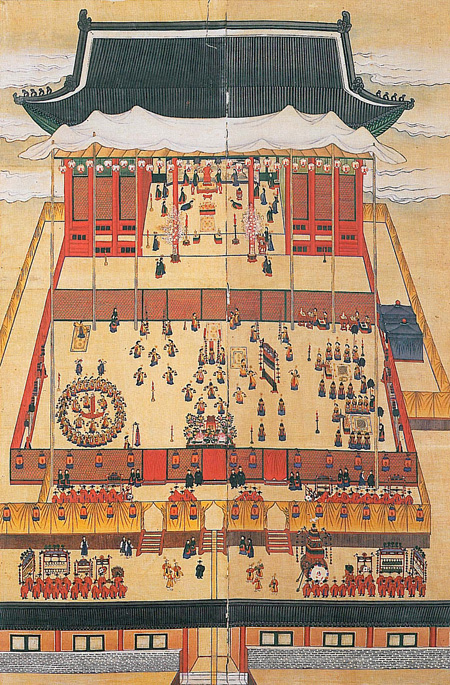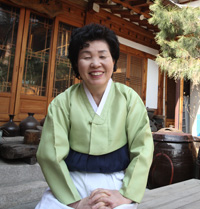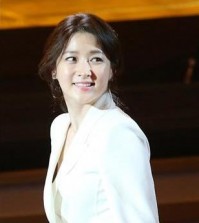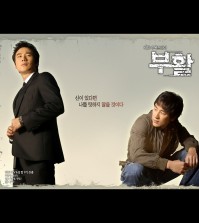- California Assembly OKs highest minimum wage in nation
- S. Korea unveils first graphic cigarette warnings
- US joins with South Korea, Japan in bid to deter North Korea
- LPGA golfer Chun In-gee finally back in action
- S. Korea won’t be top seed in final World Cup qualification round
- US men’s soccer misses 2nd straight Olympics
- US back on track in qualifying with 4-0 win over Guatemala
- High-intensity workout injuries spawn cottage industry
- CDC expands range of Zika mosquitoes into parts of Northeast
- Who knew? ‘The Walking Dead’ is helping families connect
Royal dinner at Korea House
Court cuisine artisan Han Bok-ryo reenacts queen’s dinner

A painting of “yajinchan,” a banquet to celebrate the 80th birthday of Grand Royal Dowager Queen Sinjeong in 1887 at the Mangyeongjeon Hall, Gyeongbok Palace. A royal banquet incorporates dance, music, performance, attire, table setting, lighting and flower decorations, demonstrating the comprehensive art of the Joseon Kingdom (1392-1910).
(Courtesy of Institute of Korean Royal Cuisine)
By Chung Ah-young
“The Jewel in the Palace,” the record-breaking television drama starring Lee Young-ae that aired a decade ago, not only triggered “hallyu” or the Korean wave boom but also raised public interest in ancient royal cooking. Particularly, for the international audience, the lesser-known Korean traditional court cuisine was portrayed as a fascinating, exotic delicacy.
To offer this finest dining to modern diners, a gala dinner prepared by Han Bok-ryo, designated as Important Intangible Cultural Property 38, will be offered at Korea House in central Seoul on Oct. 15 and 16.
Han is the president of the Institute of Korean Royal Cuisine founded in 1972 by her late mother Hwang Hye-sung, the second royal court food artisan. Hwang learned court cuisine from Han Hee-sun who served in the royal kitchen of Kings Gojong and King of the Joseon Kingdom (1392-1910).
The artisan will reenact a banquet which took place 126 years ago at Gyeongbok Palace. Han will present “yajinchan” a banquet to celebrate the 80th birthday of Grand Royal Dowager Queen Sinjeong in 1887 at the Mangyeongjeon Hall, Gyeongbok Palace. The banquet was prepared over two years and lasted for three days.
It consisted of 25 dishes from fruit, noodles, candies, cookies, meat to fish along with a variety of sauces, which were piled up 15 to 21 centimeters high. The gala dinner was offered along with entertainment such as dance and music.
It is a rare opportunity for modern diners to see the Joseon court cuisines made following the rules and details in the “Jinchan Uigwe” (Records Related to the Processing of Royal Banquets for King Sunjo).
“The idea with this banquet is to demonstrate how with royal dinners, the festivity and the food came together, unlike in modern days where people would go dine in one place and go elsewhere separately for entertainment or festivities,” said Lee So-young, research manager of the Institute of Korean Royal Cuisine.The gala dinner was largely driven by Korea House, which is run by the Korea Cultural Heritage Foundation with the aim to promote a higher level of Korean food.
Korean royal court cuisine was served in five courses to royal families during the Joseon Kingdom.
Usually the finest regional delicacies from eight provinces were sent to the court. Thus the royal meals boast a wide assortment of ingredients. Also, royal culinary culture affected the style of cuisine consumed by the elite “yangban” class who were frequently invited to the banquets. Naturally, the court cuisine grew to be the cream of the crop in Korean culinary culture.
Such extraordinary court cuisine has been well preserved through the Jinchan Uigwe which will be referred to by Han for the upcoming gala dinner. The royal protocol documents the details from the preparing process, rites, the list of participants, the cost of the banquets and furnishings used in the event and recipes.
















